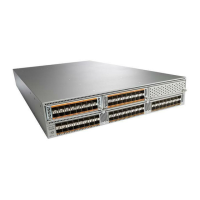CHAPTER 21
Fibre Channel Slow Drain Device Detection and
Congestion Avoidance- An Overview
All data traffic between end devices in the SAN fabric is carried by Fibre Channel Class 3, and in some
cases, Class 2 services, that use link-level, per-hop-based, and buffer-to-buffer flow control. These classes
of service do not support end-to-end flow control. When slow devices are attached to the fabric, the end
devices do not accept the frames at the configured or negotiated rate. The slow devices lead to an Inter-Switch
Link (ISL) credit shortage in the traffic that is destined for these devices and they congest the links. The
credit shortage affects the unrelated flows in the fabric that use the same ISL link even though destination
devices do not experience a slow drain.
This feature provides various enhancements that enable you to detect slow drain devices are cause congestion
in the network and also provide congestion avoidance.
The enhancements are mainly on the edge ports that connect to the slow drain devices to minimize the frames
stuck condition in the edge ports due to slow drain devices that are causing an ISL blockage. To avoid or
minimize the stuck condition, configure lesser frame timeout for the ports. You can use the no-credit timeout
to drop all packets after the slow drain is detected using the configured thresholds. A smaller frame timeout
value helps to alleviate the slow drain condition that affects the fabric by dropping the packets on the edge
ports sooner than the time they actually get timed out (358 ms). This function frees the buffer space in ISL,
which can be used by other unrelated flows that do not experience slow drain condition.
This feature supports edge ports that are connected to slow edge devices. Even though you can apply this
feature to ISLs as well, we recommend that you apply this feature only for edge F ports and retain the
default configuration for ISLs as E and TE ports. This feature is not supported on Generation 1 modules.
Note
•
How to Configure a Stuck Frame Timeout Value, page 296
•
How to Configure a No-Credit Timeut Value, page 296
•
How to Configure a Port Monitor, page 299
Cisco Nexus 5000 Series NX-OS SAN Switching Configuration Guide, Release 5.2(1)N1(1)
OL-27583-01 295

